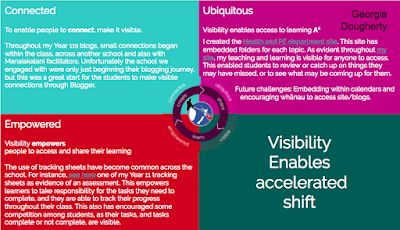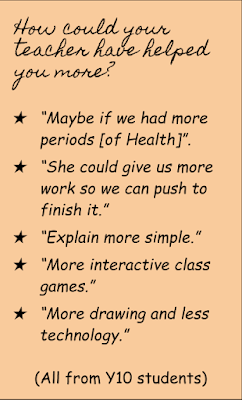Last year I queried why there wasn't an Aquatics programme at TC, especially as there is a pool 100m down the road. No one had taken the lead, so there hadn't been any opportunities for the students historically. So, I developed a water safety site and shared a short screencast showing what I had created. The purpose of the Y10 unit was to increase student confidence in, on and around the water, as opposed to a swimming unit.
I worked alongside a representative called Mark from Drowning Prevention Auckland (formerly Water Safe Inc.) to create my programme and website. When it came time to delivering the unit late Term 3 this year, Nicky, another DPA representative supported myself and the other 10PE teacher. She was incredible. Very organised, very passionate, and really increased our confidence to teach water safety. She took the lead for the first couple of lessons, and then Doris and I took over once we felt more confident.
NICKY'S FEEDBACK
- "This opportunity that you’ve provided them may make the difference between a bad decision around water and a safer decision as through the theory you’re getting them to think critically about their behaviours and attitudes around water."
- "Your enthusiasm and dedication to get this programme going will make learning so much more authentic to those who did participate in the water but also those who were “non-participants” could still learn and also see that the lessons were less about ability but more about confidence and being safe in the water."
- "Those who didn’t get in the water but were still there, some were still engaged and helpful and were good at answering questioning – think in reflection that will be a key thing, including them more with station cards or whatever it may be so they can take responsibility for some of the learning."
WHAT I HAVE LEARNT/TAKEN AWAY
- As this was the first time I was the Teacher in Charge of an EOTC activity, it was also the first time I created RAMS forms and was responsible for Health and Safety. I was blown away how much I needed to do and know, and how many people I needed to facilitate with. However, this was a great learning experience for me, and I look forward to more EOTC events!
- The unit demonstrated having theoretical and practical lessons was effective for student learning. I was able to see the progression in confidence and knowledge when students were present in both students and reflected on their practical learning. Therefore, although we had some difficulties encouraging students to bring their togs and get involved in theory lessons, this unit was a great start.
- Following on from this, the site I created was a great teaching and learning tool within the classroom. I found there weren't enough current articles on the site though, so I would like to add a page which I can continue to add news articles to. This would ensure the readings and clips are as up to date as possible.
STUDENT LEARNING
This Google Form was used at the start of the unit and the end of the unit. Students' answers were recorded in a Google Sheet, which I analysed to determine where students' confidence increased, and still potential gaps. My findings included;
- 4/61 students at start of unit identified importance of water safety as keeping safe around water, prevention of drowning and to keep safe. This gave a good starting basis to build from, and encouraged an emphasis safety in on and around water, as New Zealand have high drowning statistics, especially for Māori and Pacific people.
- 22/61 students were unsure what the red and yellow flags were at the beginning of the unit, which is also a place many of the students identified as a place they swim. So, there was an emphasis on beach safety in the second half of the unit. At the end, 8/30 students were still uncertain what the flags meant, therefore there needs to be more exploration and discussion about beach safety next year. I think this would be most effective if a day was facilitated with Surf Life Saving New Zealand as a beach day.
- At the beginning, majority of students identified lifejackets as a flotation device but by the end other flotation aids were identified including noodles, the HELP position and floating on your back. These are important for students to know if they were underprepared for the water, or are bystanders for others in, on and around the water. Many students were surprised how much they could do as a bystander!
STUDENT FEEDBACK
 The table alongside shows the increase in student confidence from the start of the unit to the end of the unit. Students were asked to rate their confidence from 1 to 5 (1 representing the least confident) before the unit, and again at the end. These percentages demonstrate a large increase in confidence. Of particular interest was no one rated themselves as 1 at the end, and only one person rated themselves as a 2. For future water safety programmes, I would like to aim for 75% of students to rate themselves as a 4 or 5, and the remaining 25% a 3 or higher, to have a greater impact on student safety and learning.
The table alongside shows the increase in student confidence from the start of the unit to the end of the unit. Students were asked to rate their confidence from 1 to 5 (1 representing the least confident) before the unit, and again at the end. These percentages demonstrate a large increase in confidence. Of particular interest was no one rated themselves as 1 at the end, and only one person rated themselves as a 2. For future water safety programmes, I would like to aim for 75% of students to rate themselves as a 4 or 5, and the remaining 25% a 3 or higher, to have a greater impact on student safety and learning.
Some comments at the start of the unit to describe the rating they gave included;
1 - Last time when I was swimming (Probably a year ago) I almost drowned, I can only put my feet in the water now as Iam scared
2 - Because I'm confident in the pool but not the beach
3 - Because not pretty sure how to get out of rips & how to save others when in deep waters
Post unit, some of the descriptions for students' self ratings included;
3 - Because I'm confident to go in the water but then the people that make fun of others distract my confidence of the lesson.
4 - Because I now know if I was stuck in a water situation I would be able to know what to do.
4 - Because I am confident to help my self if I need help.
Therefore, the water safety unit was a great first step for a new initiative within the school. I hope the programme continues to grow, to increase student confidence further to support their safety in, on and around water. Most importantly, I hope future water safety programmes help to reduce the high statistics of drownings in New Zealand waters.



